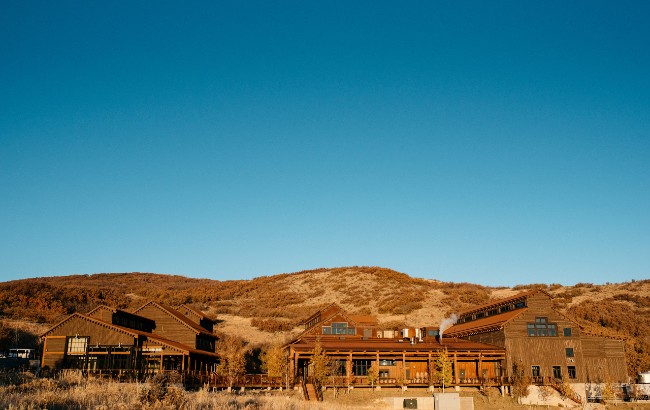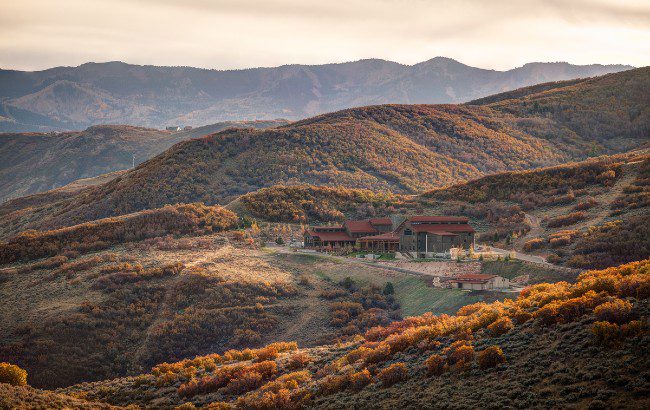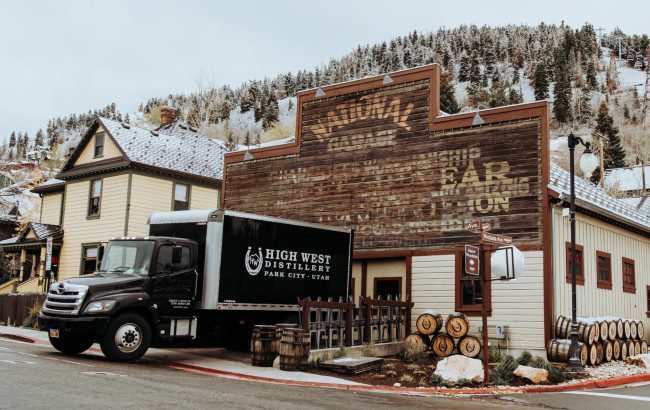High West Distillery’s unexpected tale of making whiskey in Utah
By Millie MillikenUtah’s first legal distillery since 1870, High West has spent nearly 20 years putting whiskey-making on the map in the Mormon state. Millie Milliken saddles up and heads to Park City to find out how.

Sat atop my trusty steed, Beauty, as we traverse the canyons on the Wasatch Range in a snowy but sunny Utah – a gang of scattering elk to my right, the sweeping ruggedness of (almost) endlessly undisturbed terrain to my left – the vastness of the vistas, and the setting of the Beehive State’s storied history are both in plain sight.
Utah derives its name from the Ute people, meaning ‘people of the mountains’ who were among the first indigenous people who settled in the now 45th state. Its land has been bloodily fought over, its history filled with tales of pioneers, territorial wars, and pivotally, the arrival of the Latter-Day Saints in the late 1840s, and their leader, Brigham Young. This specific time in history is also intertwined with the making of whiskey in the Old West.
Good news, as the purpose of my trip to one of the four Mountain States is to visit High West Distillery, Utah’s first legal distillery since 1870 and founded in 2006 by David and Jane Perkins. What began with a 250-gallon still in an ex-livery stable and garage on Park City’s Main Street, is now a state-of-the-art, wooden-clad, big-picture-thinking distillery, which opened in 2015 in the Wasatch-Uinta Mountains on Blue Sky Ranch in the town of Wanship and is home to Agnes, its 1,600-gallon copper pot still, an on-site ageing warehouse, high-altitude tasting room and more. Constellation Brands bought the brand in 2016 for US$160 million.
Making history
With Utah’s past and present connections to the Latter-Day Saints Church and its alcohol-abstaining Mormon religion, at first glance, setting up a whiskey distillery might not appear to be a sound business decision. Brigham Young himself is quoted as saying: “I despise the whiskey maker more than I do the thieves.” But Utah’s distilling history is much more prevalent than you may think, with beer brewed for when drinking water was bad, and distillation used for medicine.
The arrival of the American army in 1857 saw Park City’s Main Street change its moniker to Whiskey Street and in 1861, Mark Twain visited Utah and wrote later of a whiskey-like spirit he came across in Roughing It: “The exclusive Mormon refresher; Valley Tan is a kind of whisky, or first cousin to it; is of Mormon invention and manufactured only in Utah.”
By 1867 it’s recorded that around 37 distilleries were in operation, most of them owned by Mormon settlers. With the arrival of Prohibition, and the ban on private distillation in 1870, Utah entered a welcome period of abstinence until it became the 36th and final state to ratify the 21st Amendment in 1933, and subsequently alcohol was legalised again.
Seventy-three years later and in 2006, High West became part of the tale too. Five years earlier, biochemist David Perkins had a eureka moment while visiting a whiskey distillery in Kentucky. Understanding the parallels in his own work and how fermentation and distilling in whiskey works, he and Jane relocated to Park City, Utah, and in 2007 they began operations.

Having been distilling since 2009, High West has honed its process and now operates most of its production from its Blue Sky Ranch distillery. The smell of banana bread instantly hits me as I walk into the compact but busy fermentation and still room.
Master distiller Brendon Coyle – who trained at Heriot Watt in Scotland and worked in beer in Salt Lake City – has been central in building the brand’s portfolio, putting High West on the map for its rye whiskey, before beginning its Bourbon programme and being a notable name in the American single malt category too. High West’s relationship with MGP has always been a public one, and the team uses carefully vetted spirits to blend with their own distillations.
Golden age
High West’s approach to blending and ageing has earned the producer its stripes, and director of sensory and new product development Tara Lindley, who has a background in wine, is the nose and palate that steers the team when it comes to selecting barrels for blending to make their core and limited ranges. (A policy of hiring people for her sensory team from outside the whiskey industry seems to be a proven successful approach.)
I get to try a number of High West’s SKUs in the distillery’s new towering tasting room (with views of the surrounding mountains to boot). It’s a reminder of how good this distillery’s hero products are.
Its Bourbon, which Lindley says is the hardest blend, combine two-year-old, seven-year-old and 15-year-old whiskeys to create a big green apple hit on the nose, softened by nougat and vanilla; its Double Rye combines the pot-still liquid of High West and column of MGP for something that is herbal and botanical, with black pepper and clove; while its Bottled in Bond is 100% High west six-year-old rye made in one distilling season by a single distiller, and is bursting with orange peel, sultanas, lemon and toffee.
There’s also a chance to try its more limited releases, including The Noble Share, a collaboration with fellow Constellation Brands-owned Casa Noble Tequila. A blend of High West Rye and MGP Rye aged four to 10 years, and finished in Marques de Casa Noble extra añejo barrels, the result is one of the best Tequila finishes I’ve tried with cooked agave still present, and Cinnabon pastry and vanilla shining through.
Never scared of experimentation, there are some interesting casks sitting in the warehouse too. It’s hard to miss the handful of mizunara casks racked up and waiting to deliver results, while Coyle divulges that the team are playing around with concrete ageing as well.
Western hospitality
When they’re not busy making whiskey, the High West team runs a staggeringly impressive suite of hospitality offerings – one which other spirits brands would be smart to learn from. Drinking in Utah hasn’t always been easy, and even in the wake of Prohibition lifting, Utah’s famous ‘Zion curtain’ – an idea born in the 1960s and Mormonism where a physical barrier had to be put in place in restaurants so guests couldn’t see drinks being made – was alive and well until recently. Luckily, since the city held the 2002 Winter Olympics, rules around drinking have eased up in the Beehive State.

On our Thursday lunchtime visit, the Blue Ranch site’s open-plan Refectory restaurant was heaving with visitors who’d made the scenic drive (or taken the High West shuttle) up to the distillery. As well as serving up the classics – Old Fashioneds, Manhattans – original cocktails like the Dead Man’s Boots (High West Bourbon, Tequila, lime, and ginger beer) offered up lighter options alongside Great Plains bison and local trout.
It’s in the chocolate-box-house-lined Main Street of Park City (actually known as Whisky Street until 1870) though where its Saloon – and the world’s first and only ski-in gastro-distillery – stands proud, housed in what was previously the ‘National Garage’ livery stable and where a horseshoe discovered during renovation inspired the emblem on High West’s bottles.
This is where I meet High West’s head bartender Holly Booth, and her right-hand woman Arianna Hone who head up the drinks programmes across the brand’s sites. Its winter menu, based on Alice in Wonderland, surprises with innovative takes on whiskey cocktails: the Gossiping Petals combines Double Rye, mezcal, Cognac, blueberry, basil and mint; Tweedledum is a mix of Double Rye, cardamom, cinnamon, chicory, and curry; and ‘elevated cocktails’ include the brand’s more premium whiskeys like The Prisoner’s Share and A Midwinter Night’s Dram. Two doors up and a private dinner in The Nelson Cottage is a showcase of how High West combines Old West hospitality and a well-tuned presentation by its on-site whiskey ambassadors.
Eight years ago, High West produced 300,000 bottles of whiskey. In 2024, it was up to 3.3 million. As it approaches its 20th anniversary, High West’s legacy is sure to add more colour to Utah’s distilling story. Those mizunara casks will keep its fans (and new recruits) on their toes, and there is word that a blue corn expression might be on the mountainous horizon soon, too. This spirit of the American west is one to keep watching.
Related news
World Spirits Report 2025: American whiskey
